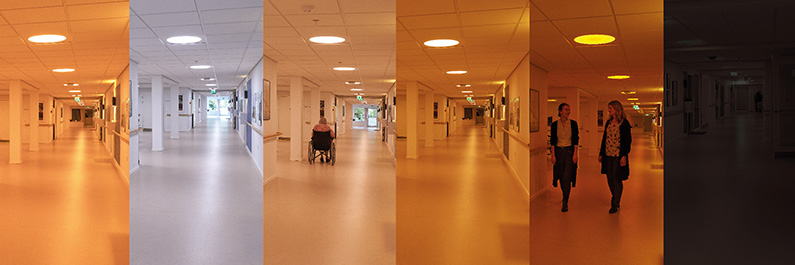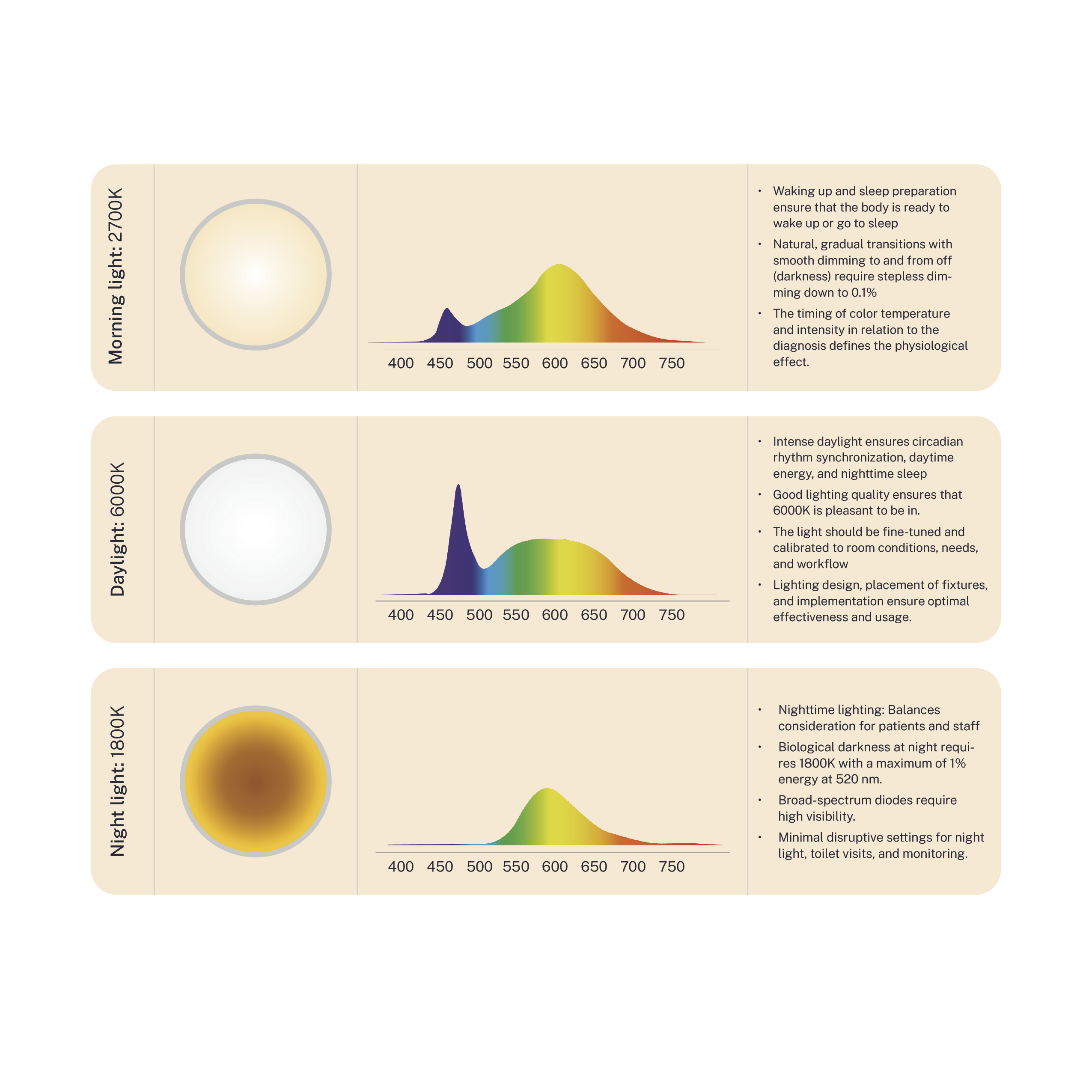An essential component of circadian lighting is the amber-colored night setting, which supports a healthy sleep-wake cycle for everyone who is exposed to it. As something quite special, the circadian lighting system caters to both the staff's need for light and the patients' or residents' need for darkness at the same time. But how is that even possible? And what are the benefits of it? Let us explain!
Every single day, the sun rises in the morning and sets again in the evening. It has a rhythm that tells us when it's time to wake up, but also when it's time to prepare for sleep and rest. Of course, factors such as location, season, and weather influence our perception of sunlight, but one thing is certain: the sun rises and sets every day. This rhythm is deeply embedded in our bodies and helps regulate our internal biological clock, our circadian rhythm.
This is exactly what circadian lighting is based on – our fundamental need for a sleep-wake cycle. In a world where we spend over 90% of our time indoors under the static glow of artificial lights, there is perhaps a greater need than ever to go "back to the basics" - and that's where circadian lighting comes in.

Despite being an advanced lighting technology, circadian lighting simply aims to synchronize our internal biological clock by recreating the natural rhythm between day and night, with color distribution and intensity being crucial aspects. By using dynamic light control of both color temperature and intensity to replicate the sunset at the end of the day, our bodies are prepared for rest. But before delving into the specifics of this amber-colored light, let's take a closer look at what circadian rhythm actually is.
What is the circadian rhythm?
We all have an internal clock in our bodies known as the circadian rhythm, which regulates various biological processes including our sleep-wake cycle, hormone production, and metabolism. The circadian rhythm is primarily influenced by external signals, most notably light. When we are exposed to bright light during the day, it sends a signal to our bodies to be awake and alert. As darkness falls, the opposite occurs. Our bodies begin to increase the production of the hormone melatonin, which signals that it is time to rest. This cycle repeats throughout our lives. However, there are periods in life where the circadian rhythm can be disrupted, such as when traveling (jetlag), illness, or working night shifts. One thing remains constant though: the human body functions best when active during the day and resting at night.
Blue* light can disrupt our circadian rhythm
One of the major culprits in disrupting our sleep-wake cycle is exposure to blue light in the evening and at night. Often, we find ourselves surrounded by light that has the same brightness and color throughout the day. Just think about how many places you encounter where the light changes color and intensity in sync with the day. Bright blue light can disturb our need for sleep and disrupt our circadian rhythm if we are exposed to it during the evening and night. This is because we have evolved to interpret intense blue light as daytime, keeping our bodies alert and productive during the day. At the same time, the production of our sleep hormone, melatonin, is inhibited when we are exposed to blue light in the evening hours. This means that our brain does not recognize that it is dark and time to sleep. It all boils down to the fact that humans should have the right light at the right time.
*By blue light we don't mean blue like the lights on a police car but rather clear white light – something that most people would describe as a cool white light.
Biological darkness in the healthcare sector
We all require complete darkness at night. However, there are places where light is needed around the clock. In the healthcare sector, patients and residents need to be monitored both day and night, which means that the staff needs light to perform their work, while patients and residents need darkness to ensure a stable sleep-wake cycle and an effective rehabilitation process. Therefore, it is important to have a lighting solution that meets everyone's needs, and that's where circadian lighting comes in.

One important component of circadian lighting is the amber-colored night light. The circadian light gradually dims as the day comes to an end, just like a sunset, signaling that night is approaching and it's time to sleep. At night, the circadian light dims completely to the amber-colored night light. It serves the purpose of providing light to the visual system while being perceived as "biological darkness" to the non-visual system. This means that the night light provides light for the staff who need to see to perform their work, while also providing darkness for patients and residents who need sleep to recover. The amber-colored night light can be seen by the eyes, but not by the part of the eye that regulates our circadian rhythm. Therefore, the endocrine functions can continue to be regulated and function normally, including maintaining the natural production of the sleep hormone melatonin, which is essential for ensuring a good sleep-wake cycle.
Circadian lighting enables a smoother transition to sleep than blue light, which signals our brain to stay awake. Minimizing exposure to blue light in the evening and ensuring biological darkness through the amber-colored night light can support the natural sleep-wake cycle and maintain a healthy circadian rhythm. This ultimately leads to increased health and well-being, both physically and mentally, benefiting both the staff who work around the clock and the patients who need the best possible conditions to recover quickly.
How does it work in practice?
The Chroma Zenit® circadian lighting system has been specially designed to consider everyone's needs simultaneously. This means that no one has to compromise or be exposed to inappropriate lighting at any time of the day. But how does it work in practice?


